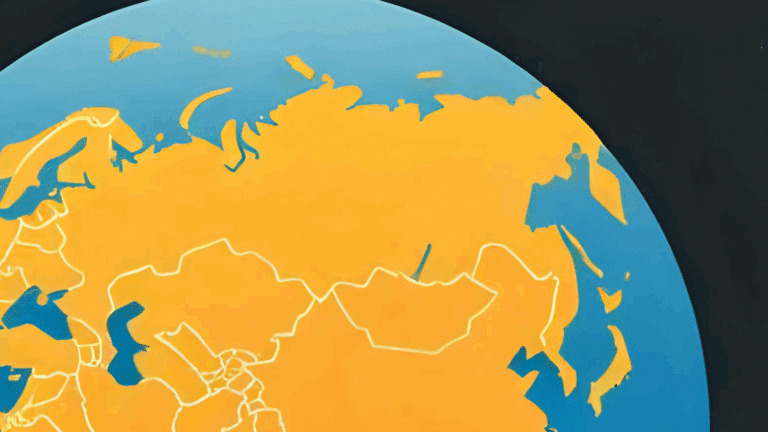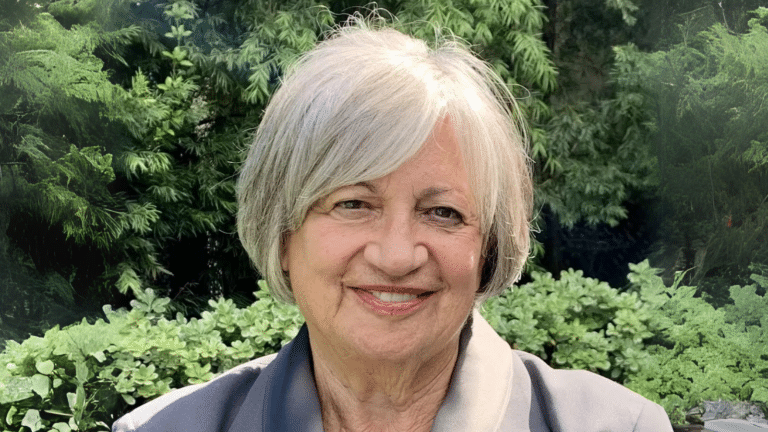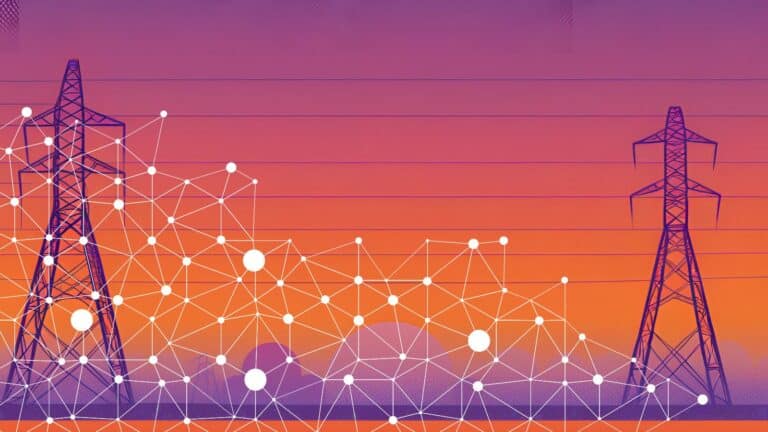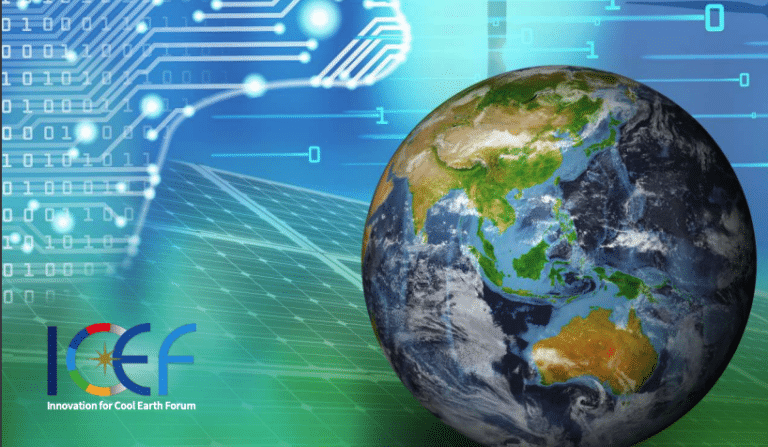Colin McCormick: I think one of the interesting dynamics as we see these AI weather models get better and better is that when they get it right, they’ve gotten it right in some interesting cases this year, and they’ve gotten it right in a way that was actually more accurate than the regular conventional weather models out there.
Bill Loveless: As 2025 unfolds we’re grappling with a sobering milestone. 2024 was the hottest year ever recorded. That pattern of extremes continues as California currently battles wildfires that have forced tens of thousands to evacuate. But beyond these headlines about rising temperatures and intensifying disasters lies a critical question. How can we better predict and prepare for extreme weather events in a warming world? Artificial intelligence may offer part of the answer. Recent breakthroughs in AI powered weather forecasting have produced new models that not only match, but sometimes outperform traditional prediction systems. These advances couldn’t come at a more crucial time. In 2023 alone, the United States suffered 95 billion in damages from 28 separate extreme weather events. Yet as AI reshapes weather forecasting, important questions emerge. How do we ensure that these powerful new tools reach the communities that need them most? How can advances in weather forecasting help operators of energy systems and what roles should public agencies play as private companies push the boundaries of prediction technology?
This is Columbia Energy Exchange, a weekly podcast from the Center on Global Energy Policy at Columbia University. I’m Bill Loveless today on the show, Alice Hill and Colin McCormick. Alice is the David M Rubenstein Senior Fellow for Energy and the Environment at the Council on Foreign Relations where she focuses on climate risk and resilience. She previously served as special assistant to President Obama and senior Director for Resilience Policy on the National Security Council, where she led the development of national policy to address catastrophic risks including climate change. Colin is a principal scientist at Carbon Direct where he provides expertise across carbon removal methods and industrial decarbonization. He previously served as senior advisor for r and d at the US Department of Energy, overseeing the applied energy research portfolio. He’s currently an adjunct professor at Georgetown University’s Walsh School of Foreign Service. Together they’ve offered a fascinating chapter in a new report from the Innovation for Cool Earth Forum, exploring how artificial intelligence could transform our response to extreme weather events. We discussed the promise and perils of AI and weather forecasting, what it means for communities on the front lines of climate change and how to ensure these powerful new tools serve the public good. I hope you enjoy our conversation. Alice Hill, Colin McCormick, welcome to Columbia Energy Exchange. Thank you.
Alice Hill: Thank you.
Bill Loveless: And in your case, Alice, I should say welcome back as we spoke a couple of years ago following the publication of your book, the Fight for Climate after COVID-19.
Alice Hill: Well, it’s a pleasure to be back.
Bill Loveless: It is indeed. Well, we speak as we witnessed devastating fires ravaging Los Angeles, another stark example of how extreme and unexpected weather can wreak havoc. And just today we learned officially from reports that 2024 was the hottest calendar year in recorded history, the latest in a string of high average temperatures. Colin, then Alice, what’s running through your minds as you think about this?
Colin McCormick: Well, Bill, I think people who have worked in climate and clean energy for a long time see these numbers as tragic but expected. We’ve seen these trend lines for years, and so from one point of view, nobody should be surprised. On the other hand, I keep hearing from family and friends who are not in the climate space and are just sort of living their regular lives, that they’re really starting to understand how real this is, how immediate it is, and how much it is affecting regular people’s lives. It’s not theoretical or far off in the future, it’s now it’s in their neighborhood and it’s going to affect them and their families. So I guess I increasingly see a transition of awareness among ordinary people who haven’t professionally dealt with or thought about climate issues that this is coming home.
Bill Loveless: Yeah, Alice,
Alice Hill: Well, certainly a tragic moment. I lived in LA for 25 years and the community that I lived in is on full evacuation and the adjoining community has burned. It is a tragedy. I’ve focused on wildfire for over a decade, but the size of this event, the ferocity of the burning and the fact that whole communities are wiped out, really has stretched everyone’s imagination. This is the big one when it comes to wildfires in this wildland urban interface where communities, but right up to the hillside and grasslands forest. But as you’ve noted, we have really distressing news that for an entire year we breached that 1.5 degrees Celsius mark of temperatures being above pre-industrial levels and with global warming that brings hotter, drier conditions like what Los Angeles has experienced. It had a couple of years of heavy hardier rains, and so the vegetation is very high, and then the Sena and Anna winds, which usually hit in the fall, hit in January, but we’re carrying hurricane four scales that spread those embers wide and the nature fires themselves have changed.
They burn hotter, they move more quickly as a result of the hotter dryer conditions. So it is a sad moment. I’m hoping as Colin says that it serves as a wake up moment. It certainly will provide many lessons on how we can better prepare for wildfires going forward because we will see which home survived, which didn’t, where we lack evacuation routes, how we can do better preparations, making sure that we’re not relying on fire hydrants alone in these wildland urban interface fires. But it is sadness all around and very tragic for the people in Los Angeles.
Bill Loveless: You both contributed to a chapter and a recent report from an organization called the Innovation for Cool Earth Forum. That report as a whole provides a roadmap for artificial intelligence and climate change mitigation. Your chapter is a fresh look at extreme weather response. But before we get into that, Colin, can you explain what is the Innovation for Cool Earth Forum?
Colin McCormick: Well, ICEF is an annual conference that’s hosted by the Japanese government, the Ministry for Economy, trade and Industry. And it is a form to bring together leaders, technologists, policy makers, business leaders who are looking at approaches to mitigating climate change that includes innovative technologies and it includes deep dive looks at specific areas where technology can support decarbonization. I and other colleagues have worked every year for now a decade, I think, to prepare deep dive studies of specific areas where technology can help with climate change. This year, and in fact last year as well, our focus was, as you said on AI and climate change. Both of these are huge topics, both may be moving much faster than most people can really keep track of, but ISEF broadly has really been a wonderful annual event to enable these deep dive roadmap looks at specific technologies for Kleinman
Bill Loveless: And some rather impressive names associated with that organization. In addition to each of you, there’s for example, Nabu Tanaka, the former head of the International Energy Agency, Sally Benson, an official at the Biden Office of Science and Technology policy, and of course our own David Sando, the inaugural fellow at the Center on Global Energy Policy, who’s been involved in overseeing much of this work over these years. Alice, how did you get involved in this forum?
Alice Hill: Well, it’s one of those classic stories. Someone introduced me, a mutual friend introduced me to David, and David mentioned that he was working on this and asked me if I was interested in participating. I, of course was, I was very excited to be a part of it. And then David said, I have a wonderful colleague friend to work with you if you would like to, and that of course was Colin. David was absolutely right. It was a lucky connection for me, and Colin and I have worked on that article and then subsequent pieces as well. It’s just been a very happy collaboration,
Bill Loveless: And it’s an interesting chapter that you write. You note that the safety and economic benefits of improved weather forecasts are huge, and you cite a world bank analysis that estimates the early warning systems could reduce annual deaths from weather events and cut economic costs by 35 billion a year in the us. You add forecasting improvements since 2007 have saved an average of 5 billion per hurricane, and for the most part, Alice, those benefits have resulted ahead of the proliferation of artificial intelligence, right?
Alice Hill: Yes. This is based on historical data, the projections based on that. But with ai, we can leapfrog ahead in the accuracy of the predictions and lowering the cost of producing those predictions, which could be the basis for a very strong set of early warnings going out to communities in a timely manner to save livelihoods and lives.
Bill Loveless: And Colin, you teach a course at Georgetown University that addresses artificial intelligence and an energy context. You’ve been doing this for quite some time, right?
Colin McCormick: Well, that’s right. AI has been a fascination of mine for a long time. The technology has so much promise. One thing I’ve observed for quite a while and others have too, is that the applications of AI for commercial purposes that are unrelated to climate are going fast. Lots of talent, lots of money, lots of amazing technical advances. But some people like myself and many other, many other researchers and experts well before me have asked this question, couldn’t we use this incredible power, these incredible AI tools to address climate, which is of course, among basically the greatest challenges that we face today. And the answer is yes. We explore that in detail in the report. One of the key barriers we’ll come back to many times I think in this discussion though, is that the AI expertise community and the community of experts like Alice, who are very, very deep on climate and adaptation topics are very different communities. They speak different languages, they have different understanding of how technology works, and they have different frameworks for how to make progress. So one of the key issues we focused on in the IEF report is how to bring those two groups of expertise together, how to bridge that barrier and help aim the powerful AI capabilities at real climate problems that will really make progress. So that’s a key topic that we looked at repeatedly in the study.
Bill Loveless: And just given our interest in energy policy here at the Center on Global Energy Policy, it’s important to note the implications for secure energy supplies of good weather forecasting. Right? I’m recalling, was it about four years ago at this time, an extreme weather storm and caused a massive electric power failure in Texas that led to loss of life and billions of dollars in property damage?
Colin McCormick: That’s absolutely right. I think there’s a lot of ways that AI and machine learning are impacting energy supplies in general. There are immediate on the ground uses to optimize or increase the power generation from solar and wind facilities. There’s ways to anticipate when extreme weather may damage infrastructure. I’ll let Alice speak more detail about that. But one of the wonderful things we see about the power of AI based extreme weather forecasting is that it can give much more lead time to be able to harden that infrastructure, take the appropriate measures to dispatch other generation and try to provide more robust critical services. In the power sector.
Alice Hill: There’s just a explosion of startups using ai, for example, for the electric grid to make it more efficient, but also to be more predictive of these extreme weather events. For big power companies in wildfire prone areas, they have had to resort to preemptive shutdowns of power to avoid, for example, a line being pushed down by the winds and then igniting a fire on the ground and causing widespread destruction, which has happened numerous times. So using AI to better understand where there’s a likelihood of that to occur, or there are places where because of the topography, it’s more likely for an ignition or modeling where fires might spread, can all help a utility better understand how to discreetly protect the grid without having to do these massive shutdowns. And we’ve seen improvement in recent years from the utilities and the startups are certainly eager to supply them these tools to better serve their customers. So there’s just really an arms race out there now for applying AI in many contexts in the delivery of energy.
Bill Loveless: As you note to Alice, and there have been significant advances in artificial intelligence in this particular field. Where is there the need to further improve it? What steps are being taken to sharpen this technology?
Alice Hill: Well, I will defer to Colin for that.
Colin McCormick: Well, there are a lot of ways in which AI and machine learning tools are being applied to the energy system, and some of them are pretty unintuitive. For example, a major challenge today in deploying clean energy is the interconnection queue, the vast number of projects that are trying to connect to the transmission grid, but need to go through lengthy studies at the moment that can stretch as long as five years for a project to actually go from application to commercial operation. One way to approach that is to use AI tools like large language models to help speed up the review of the documentation that’s submitted to ISOs and utilities. That’s a very different kind of ai, but it’s leveraging the same advanced capabilities that these algorithms are showing to be able to accelerate and improve the energy system.
Bill Loveless: There’s so much available there, and I’m sure we’re seeing much of it applied in the United States and Europe and other places, but much of the world doesn’t have very sophisticated forecasting options to begin with. Things like early warning systems. In 2022, the United Nations called for a concerted global effort to improve early warnings around the world by 2027. You note in the chapter, Colin, to what extent are these systems available in other parts of the world, particularly among least developed and small island nations?
Colin McCormick: Well, weather forecasting is largely a capability that wealthier countries possess. It does require investment in trained meteorologists, meteorology services, weather sensors and weather stations and advanced computing tools. So to give you an example of that, Europe has a supercomputer facility that is used to run very advanced, very sophisticated weather forecasting models that service the European Center for medium range weather forecasting has a healthy budget and provides great great value with the forecast that it generates. But that level of investment is way out of reach for many developing countries globally. So in many cases, what you see is that those countries rely on older, less accurate weather forecasting systems that don’t have the data to back them and don’t have the compute power to really power them. And that’s I think at the of what you were just describing with the UN push towards improving that globally.
Bill Loveless: No easy task, I would think, right? Because again, you just simply don’t have the infrastructure in some of those countries to take advantage of applications that are becoming available.
Colin McCormick: I think that’s right. Infrastructure’s interesting topic because there’s many pieces to it in terms of looking at a full set of early warning systems and weather forecast. There’s the compute infrastructure, which I mentioned briefly, the idea of having very, very powerful supercomputers. There’s the infrastructure around weather stations that can, and satellites that can detect current weather conditions, which are needed to calibrate these weather forecast models. And then there’s the human infrastructure. There’s the expert meteorologists who know how to run those sophisticated computer models, validate them and translate that into a weather forecast. Now, at the same time, that’s not the end of the infrastructure. I’m going to hand it over to Alice here because of course, even if you have a wonderful weather forecast in the hands of some expert meteorologist, that’s a long way from necessarily getting that to people who are exposed or in danger and who could use that weather forecast to take action.
Alice Hill: Well, you’re absolutely right, Colin. There are barriers. Even if you have the best forecast in the world, if it’s not received and acted upon, it isn’t really worth much. So we know, as you’ve said, bill, there is a huge swath of the world, just a short of 50% of the world lacks multi hazar early warning systems, and the place that lacks it the most is Africa. They simply don’t have the infrastructure as we’ve been discussing or the meteorologist or really the data, the historical data from observation to be able to produce accurate forecasts and then to disseminate them. The dissemination really requires coordination across civil society. It’s the emergency managers, it’s the weather forecasting service, it’s local mayors, communities, communication systems. And we see, for example, the risk of false warnings that just happened in Los Angeles. Los Angeles accidentally sent out an evacuation order to all residents in Los Angeles during these fires, and it turns out they did the same thing to a smaller group of people in 2018.
So ensuring the accuracy of the early warnings is very important. And because people already know that sometimes these warnings are inaccurate. You can think of a warning of a storm in Florida that’s ordering an evacuation, and it turns out the storm never hits. So then people think, Ugh, that’s not going to happen to me the next time the storm happens and the warning comes through and then they don’t act. And that happened just recently in Mayotte Archipelago in Africa where there was a good warning of a cyclone about to hit 50 hours before it hit, but people just ignored it. They didn’t think it applied to them, and then there was loss of life and further damage as a result. So we have the cognitive biases that people think it doesn’t really affect me, and we also have errors, and then we have to have the right forecast from the get go.
All of this requires money coordination, regional planning, a lot of hard infrastructure. But I’d also set say, soft infrastructure or relationships that are trusted where people come to rely on the system. One place that has done an excellent job that doesn’t have a lot of money is Bangladesh. They have really, since the 1970s, taken cyclone warnings very seriously, and they’ve used a system that can rely on as simple a measure as somebody walking around a village with a bullhorn, and they had people going out on bicycles further out, even into remote areas to tell people to get to safety, and many people do. And so the death rate from cyclones in this country that’s not as wealthy as the developed world has just plummeted. That’s a huge victory and demonstrates why early warning is so important and how it can really change the future for people on the ground. AI is going to be a big boost for that.
Bill Loveless: Interesting. How we could learn in this case, honestly, from a lesson in Bangladesh that it could apply throughout the world, even here in the United States, it just seems sort of, it’s not only a matter of understanding the technology that’s available and more importantly the results of that technology, what it tells us about forecasts and extreme weather, but how we respond to it, public acceptance. And I guess again, back to what we talked about initially about Colin was saying he thinks that maybe with this fire in LA, maybe more people are going to become that much more aware of the risks associated with climate change. And when it comes to extreme weather so that people don’t treat reports of hottest year wreckage, they’re simply sort of a dime a dozen occurrence, bill.
Colin McCormick: I hope so. I think one of the interesting dynamics as we see these AI weather models get better and better is that when they get it right, they’ve gotten it right in some interesting cases this year, and they’ve gotten it right in a way that was actually more accurate than the regular conventional weather models out there. And that creates a really interesting tension. So a good example actually was in July when Hurricane Barrel came, the Atlantic hurricane season, hurricane Barrel in early July was headed west to Mexico, and the conventional forecasts had it continuing on to hitting on the Gulf Coast of Mexico. The AI weather forecast tools, particularly the one from Google, gave a different prediction and predicted that it would turn north and actually make landfall in Texas. It was a surprising right turn that that AI model called, and that creates some real problems for forecasters and for local authorities.
Do you trust this new emerging AI model that says something different? And it turned out the AI model was right, it got it right. It called the path, right? Many days before the conventional models caught up as the tracks started to shift, the conventional models adjusted the forecast, but they were days later. And I think first of all, that illustrates some of the power of these novel AI models that give many, many earlier days warning of a specific location for a hurricane landfall. But it also illustrates the dilemma that some officials and community members are in right now. So here we have this very novel, a year, 1-year-old, less than a year old in some cases, AI models that are very complicated and developed by a private company. We’ll get to that point in a moment. Do I trust it? Do I listen to that prediction rather than these conventional years, long years old models? So that’s a hard one, but we’re going to be chewing on that problem.
Bill Loveless: It lends some complexity to weather forecasting, huh?
Colin McCormick: Sure does. And there are real consequences, as Alice pointed out. If you call it wrong and you say, look, I’m a local official. I’m going to say we’re going with the AI forecast. That’s a fraught decision. And there’s some, I think, important questions about what the threshold of certainty is. The AI weather models have really been tested in this very scientifically rigorous manner. Or you can read the papers in nature that give you the statistical tests, and anybody with their scientist hat on says, oh, yeah, boy, I see that’s got a fantastic statistical performance. But that’s a long way from what this looks like if it’s really your community and your home, and also you are the local disaster official who’s got to really make the call here.
Bill Loveless: I found interesting. Colin, you mentioned Google. There’s been obviously tremendous breakthroughs in this field, AI based weather modeling. I mean, you note in the report does Alice, that in 2023, Huawei, the Chinese communications tech conglomerate released its first or the first AI based weather model that you say not only matched the accuracy of conventional models, but significantly outperformed them. And since that breakthrough, several other companies have released AI-based weather forecasting models, including Google. Tell us a little bit about these breakthroughs.
Colin McCormick: I’ll start by saying that researchers have looked at the power, the potential of using AI for weather forecasting for quite a few years. So this is not a completely novel idea. What happened in late 2023 was that one of these models, the Huawei one as you mentioned, made some big advances. It started using some slightly different algorithms under the hood, and it was able to perform in a really impressive way. So there had been earlier AI-based weather forecasting models that just hadn’t been in very good, so nobody paid much attention. But that model Pango weather and then followed not to long after that by Google’s graph cast and some more recent models as well have really come on the scene very rapidly. They’ve used some different machine learning methods under the hood. They’re also moving tremendously quickly. We released this ISEF study in late November, so we’re not even two months ago.
Since then, Google has released another generation of weather forecast models, gen cast, just a few weeks ago, which has shown yet more improvement in accuracy. So that to my mind, illustrates both some excitement if I think if you’re a researcher in this space, this is such a fantastic exciting time. But it poses real challenges for thinking about how you incorporate this in any deployed weather forecasting system as part of an emergency management strategy. This is moving super fast, and how can officials, policymakers, regular people keep tabs on it and keep up with it and make decisions and judgements on the performance of these models? This is tricky stuff.
Bill Loveless: I want to touch on that in a moment, the role of government policy in this area. But before we do, I just want Kyle, maybe you can point out to us what are the barriers to adoption of these advances in AI and weather forecasting? You’ve sort of alluded to some of them, but what should we keep in mind to
Colin McCormick: Start with? There’s questions about how to deal with accuracy, how to test them, how to compare their performance. There’s questions about how to communicate that. I think there’s barriers also having to do with capabilities and personnel. So government meteorology offices in the United States, Noah in Europe, E-C-M-W-F that I mentioned, they are working hard to stay abreast of this technology, and in some cases they’re collaborating closely with the developers. But clearly there’s a resource question around how governments can have sufficient AI expertise in-house to work productively with these very well-resourced AI teams at these large multinational companies.
Bill Loveless: Alice, you’ve had, like Colin, have had substantial experience in government at the Homeland Security Agency, for example, and you and Colin write in this report that government agencies will likely require additional funding to evaluate emerging technologies for accuracy and reliability. Given the speed with which these technologies are changing, this need for funding could only increase over time. How should that money be spent?
Alice Hill: Well, I think that as NOAA and NASA have done over the years, they’ve looked for the best technologies, the best science to help support the United States and make sure that the United States has accurate forecasting accurate information going forward, we will need to focus on that mission. One of my worries is under the Trump administration, whether that will happen, certainly in Project 2025, which President-elect Trump has distanced himself from however a number of his proposed appointees worked on that project. That project really proposed a substantial cuts to Noah and some privatization of the weather services and not opposed to privatization of information regarding weather. But one of the fundamental concerns is that we have a public good of sound weather forecasting. For those who can’t afford to subscribe to a service, corporations can handle that. They can get more detailed forecasting, but for ordinary citizens, the citizens of Los Angeles, of North Carolina elsewhere, they need to have government or at least free information available.
And one of the challenges is if we rely on the goodwill of the corporations who many of them are making these AI tools that people are exploring right now available for free, but if that doesn’t last, what happens? And at the core, we need the public good of weather services, which includes accurate forecasting, and therefore there need to be investments including in ai, but also fundamentally supporting monitoring data collection. If we reduce the number of monitors out there, AI can assist us, but we also need to be able to test against real time events as well.
Colin McCormick: Alice is absolutely right. First of all, I’m a huge fan of noaa. I think it’s one of the most underappreciated federal agencies that delivers just such huge value to the United States for a tiny, tiny budget cutting. It would be nuts. I think the other point is that while the models that we’ve seen, these AI models have been developed by these large technology companies, they fundamentally rest on data that has been collected and is continuing to be collected by public weather services. These models can’t function unless they have ongoing observational data fit into them, and that’s coming from noaha weather satellites or European government weather satellites. It’s coming from ground stations that are operated by government weather services. These models are also trained on decades of historical weather observation that has been collected and curated and released by public agencies, by government weather services. So I think it’s important to recognize that while the big flashy releases and the AI components have drawn very, very heavily, obviously on advanced private AI technology companies, they’re built on a foundation of public investment in weather services, weather data collection, and careful curation of those data sets over decades.
We can’t imagine that private AI weather models could somehow obviate the need for public investment in weather data collection and meteorological services.
Bill Loveless: Colin, it raises an interesting point too of we often hear about the demands for electricity that data centers and all require, and it’s a big problem and people worry about it. Oh, here we’re talking about another substantial use of energy to generate this new technology for weather forecasting, but I get the feeling that it’s worth it.
Colin McCormick: Yeah, I agree. Certainly there’s some AI applications that consume enormous amounts of energy. These LLM based chatbots indeed are requiring lots of energy. One interesting thing about these AI weather models is in fact, when they’re put into production, they use far less energy than conventional weather forecasting. To put some numbers on that, the graph cast models and similar ones when they actually make a forecast are using a hundred to a thousand times less energy per forecast than conventional models using supercomputers do. Now, that’s not the whole story for energy to build those models, train them, did take energy. We discussed that in the report, but the total lifecycle energy consumption of these AI-based weather models does seem to be substantially less than conventional weather forecasting models.
Bill Loveless: This has been such an interesting discussion of ai. Still another, there are so many things we can talk about when it comes to artificial intelligence, but none, it seems more important than the one we talked about today. Alice Hill, Colin McCormick. Thanks for joining us today on Columbia Energy Exchange.
Alice Hill: Thank you.
Colin McCormick: Thanks so much.
Bill Loveless: That’s it for this week’s episode of Columbia Energy Exchange. Thank you again, Alice Hill and Colin McCormick, and thank you for listening. The show is brought to you by the Center on Global Energy Policy at Columbia University School of International and Public Affairs. The show is hosted by Jason Bordoff and me, Bill Loveless. The show is produced by Erin Hardick and Anne Bailey from Latitude Studios. Additional support from Caroline Pittman, Victoria Prada, and Kyu Lee. Sean Marquand is the sound engineer. For more information about the show or the Center on Global Energy policy, visit us online at energypolicy.columbia.edu or follow us on social media @ColumbiaUEnergy. If you like this episode, leave us a rating on Spotify or Apple Podcast. You can also share it with a friend or colleague. To help us reach more listeners for more on AI and energy, see a blog from the Center on Global Energy Policy called Energy Explained and coming out in February, check out AI Energy and Climate Podcast, a new show hosted by the Centers inaugural fellow, David Sandal. Thanks again for listening. See you next week.










